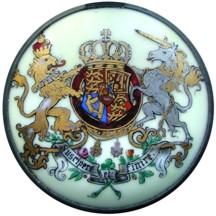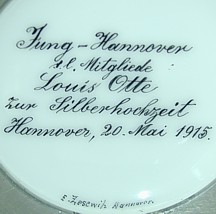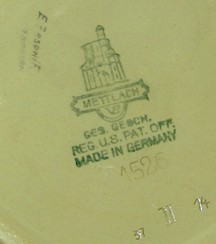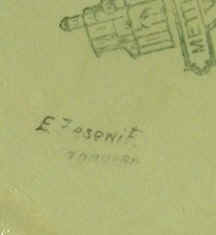
 Stein Collectors International
Stein Collectors International
Featured Stein: April 2006

 Stein Collectors International
Stein Collectors International
Featured Stein: April 2006
A Custom-decorated Mettlach Stein
by SCI Master Steinologist Walt Vogdes





|
The stein seen at right is a custom-decorated Mettlach
1526 body with a porcelain inlaid lid. Mettlach sold many undecorated bodies to
finishing shops all across Germany. These shops employed painters and
pewtersmiths to decorate steins to fill custom orders from royalty, student
associations, athletic clubs, and other groups or individuals who wanted a
special design. In this case, the arms on the body were handpainted, and the
stein was mounted with a porcelain inlay in pewter. The standard Mettlach base
marks indicate the stein itself was made in 1914. The inscription inside the lid
indicates that the stein was a gift in the following year from the Jung-Hannover
to member Louis Otte on his silver anniversary. The name of "E. Zescwitz,
Hannover" appears below the inscription as well as painted on the base,
identifying the firm which decorated the stein.. At first glance Mettlach collectors might find this stein somewhat "suspicious". The contrast between the tan body and the bright white of the porcelain insert is a little bit off-putting, and while the coat of arms on the body looks sufficiently "Germanic", the arms on the inlay are quite different, and they look more like an English royal design. All in all, what are we to make of this? Let's see what we can learn from the clues on the stein. A Google search of the internet for the words "white horse red shield" returns almost 5 million hits, but the ones at the top of the list are the only ones we will need. The sixth site in the list of links is for the Kingdom of Hannover (see Reference below), a promising alignment with the inscription and the location of the decorating firm. In fact, we quickly learn that the white horse and red shield have been widely used for centuries as civic arms in northern Germany, including Braunschweig, Hannover and Oldenburg. Hannover was chartered as a city in 1241, although the settlement existed as early as 1100. In the 14th century the city was fortified with a solid city wall, and was an important member of the Hanseatic League. From 1636 it was the capital of the Dukes of Braunschweig-Lüneburg. In 1692 Ernest August was made an Elector by Emperor Leopold, and by marriage he linked the Hannover and Stuart families. Upon his death the title Elector of Hannover passed to his eldest son George. The Electorate was elevated to a kingdom in 1814 as a result of the German conflict with Napoleon, whereby George III became King of both England and Hannover. In 1837 the two thrones were separated as a result of Salic law which prevented a woman from succeeding to the crown of Hannover. Hannover continued as a kingdom until 1866 when it was annexed by Prussia in the Treaty of Prague, and made into a province, with the city of Hannover as its capital. The province gave up its individuality again in 1916 when it was united with Oldenburg, Brunswick and Schaumburg-Lippe as the modern state of Niedersachsen (Lower Saxony). With this information to channel our research, it is quite easily determined that the coat of arms on the inlay are the royal arms adopted by George III, who was simultaneously King of England (from 1760) and Hannover (from 1814). They are described as "the arms of the United Kingdom surmounted with the three-fold escutcheon of Brunswick, Lüneburg and Hannover, with over all the crown of Charlemagne witnessing to the electoral dignity." So, all the pieces dovetail together. This stein, which was proudly presented to Louis Otte in 1915, displays the civic and royal arms of the province of Hannover. References:
|